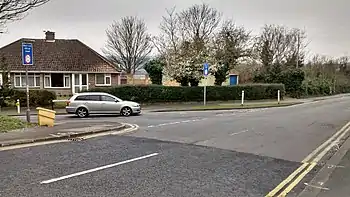Junctions (software)
Junctions is a software package by Transport Research Laboratory. It incorporates ARCADY, PICADY and OSCADY which were previously separate programs marketed by TRL. The latest version, Junctions 10, was launched Wednesday 3rd February 2021.[1]
| Developer(s) | Transport Research Laboratory |
|---|---|
| Stable release | 10.0.0
/ February 2021 |
| Operating system | Windows |
| Type | Traffic software |
| License | Proprietary software |
| Website | https://trlsoftware.com/products/junction-signal-design/junctions/ |
ARCADY

ARCADY is the acronym for (Assessment of Roundabout Capacity And DelaY). This software, produced by the Transport Research Laboratory (UK), models traffic capacity, queues and delays at roundabouts.[2] The software is largely based on empirical relationships between roundabout geometry and capacity, which were established as the result of extensive research carried out on existing roundabouts on the UK road network, as well as controlled test track facilities over a period of over a decade.[3]
The program is used by traffic engineers when assessing existing layouts or when analysing the impacts of proposed design changes. Estimates of annual accident frequencies can also be obtained.[4]
The capacity and safety relationships which ARCADY utilises are discussed in the UK's Design Manual for Roads and Bridges.[5]
RODEL is similar to ARCADY and utilises TRL equations under licence from TRL.
Recent developments
From ARCADY 7 onwards, the software has been capable of communicating with certain CAD software, aiding real-time design analysis.
ARCADY 7 introduced the ability to model simple networks of linked roundabouts.
In ARCADY 8, the Highway Capacity Manual 2010 methodology for roundabout analysis was made available.
ARCADY 8 also introduced a simulation technique to deal with the modelling of certain configurations such as lane usage at roundabouts.
'ARCADY Lite' is a simplified version of ARCADY 8 that provides basic analysis of roundabouts.
ARCADY 9 includes built-in tools for graphically measuring roundabout geometries and for assisting with the transfer of traffic flow data from other sources (typically spreadsheets).
ARCADY 10 is now fully integrated and available as a module within Junctions. Updates include a number of new modelling scenarios to be evaluated such as priority chicanes and one-ways. North American users also have the option of using the HCM 2010 model (using HCM 2016 roundabout coefficients) to analyse roundabout designs.
PICADY

PICADY (Priority Intersection Capacity and Delay) is a program for modelling three and four arm priority junctions in a similar manner to ARCADY. It is based on empirical relationships which link capacity and safety with road geometric parameters such as carriageway widths and visibilities.[6] These relationships are discussed in the UK Design Manual for Roads and Bridges.[7]
PICADY can also model pedestrian crossings on the approaches to priority junctions.[8]
PICADY 5 can model the following junction forms:
- T-junction (3 arms)
- Straight crossroads (4 arms)
- Staggered crossroads (4 arms)
PICADY 9 includes Highway Capacity Manual 2010 models for Two-Way Stop-Controlled and All-Way Stop-Controlled intersections.
PICADY 10 now offers the ability to calibrate models in all circumstances, by applying adjustments to the model’s individual traffic movement raw capacities. Models applicable to North America allow users to setup and model Two-Way Stop Controlled (TWSC) and All-Way Stop Controlled (AWSC) intersections.
OSCADY
OSCADY (Optimised Signal Capacity and Delay) calculates capacities, queues and delays for isolated (uncoordinated), traffic signal-controlled junctions. It can evaluate a set of known signal timings, and optionally it can optimise stage lengths and/or cycle time to minimise delay. More recently, an extension to the simulation mode allows the performance of simple adaptive signal control to be estimated.
OSCADY is intended to be used at relatively simple signalised junctions (or temporary signals at road works) where the emphasis is on setting up model runs quickly and easily, but can model junctions that include flared approaches and opposed right turns. Its integration with ARCADY and PICADY means that users can switch a junction between priority and signalised options and compare the results within one package.
Optionally, signalised junctions can be evaluated in Lane Simulation mode which offers additional functionality, such as the ability to model intermittent stages and partially signalised junctions, including signalised roundabouts. In Junctions 10 the simulation mode capability has been extended to allow the performance of simple adaptive signal control to be estimated. This model can be applied to temporary signals (such as at roadworks) and some control over the controller logic is provided in order to mimic behaviour whenever there is no demand at any point within the modelled time period.
References
- "Junctions 10 Features". TRL Software. Retrieved 2021-02-02.
- Kimber, R.M., The Traffic Capacity of Roundabouts, TRL Laboratory Report LR942, 1980.
- Roundabout Design for Capacity and Safety: the UK Empirical Methodology
- Maycock, G. and R.D. Hall, Accidents at 4-Arm Roundabouts, TRL Laboratory Report LR1120, 1984.
- DMRB TD 16/07: Geometric Design of Roundabouts
- Kimber, R.M. and R.D. Coombe, The Traffic Capacity of Major/Minor Priority Junctions, TRL Laboratory Report SR582, 1980.
- DMRB TD 42/95: Geometric Design of Major/Minor Priority Junctions
- Transport for London, Traffic Modelling Guidelines v3.0, http://content.tfl.gov.uk/traffic-modelling-guidelines.pdf